What is Amorphous Silicon? You already know about the silicon based solar panels that are…
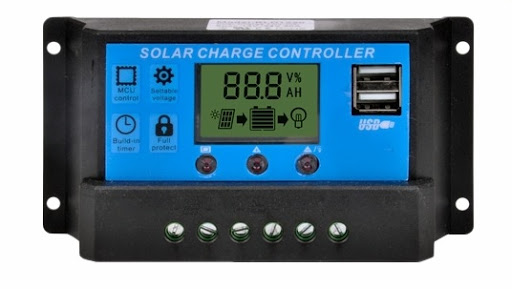
All about Charge Controllers
In solar PV off-grid applications, you use batteries to store energy generated from solar panels. In a typical off-grid system, you’ll have solar panels, batteries and DC or AC loads. But you can’t connect solar panels directly to the batteries because solar panels give out a higher voltage compared to battery voltage and this voltage is also constantly changing due to amount of sunlight that falls on to it. On the other hand, batteries are also not designed to get charged in this manner because you will have to consider things like battery type, temperature, depth of discharge (DOD) etc.
Having said all that, you can still connect solar panels straight to the batteries to charge them. Most of the time it works well. But you’ll destroy your valuable batteries by overcharging them. I hope nobody want to end up like that. So, there must be a device which can manage all this. This device is called the solar charge controller.
Charge controller is an intelligent electronic device which can control all above factors and make sure it gets most out from solar panels and charge and discharge the batteries smoothly. Your batteries will last long as well. Nowadays there are many types of solar charge controllers available in the market under different brand names. Quality and functionality of them differ with the price. Among them we can identity 3 main types of solar charge controllers. They are as follows:
- Shunt charge controllers (rarely used now)
- PWM charge controllers
- MPPT charge controllers
Shunt is a very basic type charge controller. It simply acts like an electronically operated switch to turn off the input current supply when the battery is fully charged. It’s rarely used nowadays. So, I’m not going to talk about that in here. PWM and MPPT are the 2 popular types that you will find in market nowadays.
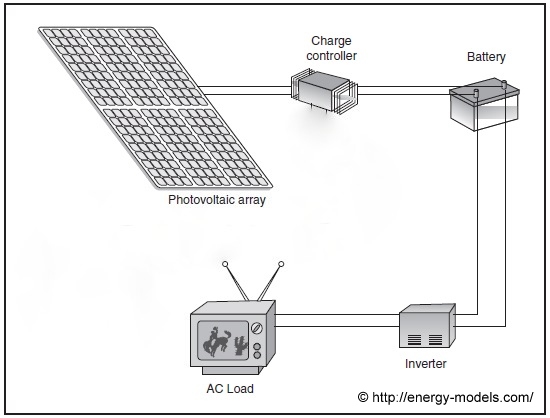
A typical solar PV off-grid setup
PWM charge controllers
PWM stands for Pulse Width Modulation. It’s a method of reducing the output voltage by using a series of On and Off voltage pulses at a constant frequency, along with varying duty cycles (the fraction of time that the output voltage is “ON” compared to when it is “OFF”). Following diagram will explain this better.

Pulse Width Modulation method
In simple terms, PWM charge controller is nothing but an electronically operated switch connected in between solar panels and batteries. It takes in solar panel voltage, make pulses as you see in above graph and control the duty cycle to match it with battery voltage. This is how it operates simply.
In PWM charge controller, the solar panels and the batteries are both directly connected. It doesn’t isolate these 2 sides like MPPT controllers do.
Let’s investigate more on how this device control the output voltage. Think that you have a 100W solar panel with 18 Vmp and 5.56 Imp. You also have a 12V battery which is 14V of charging voltage. If you connect this panel and battery with a PWM charge controller, you’ll get following values.
Input (Solar panel side) – 18V x 5.56A = 100.08W
Output (Battery side) – 14V x 5.56A = 77.84W
Notice the difference? You don’t get much output wattage compared to the input. The batteries only receive 77.84W from a 100W panel. The power loss is 22.24W. That is a big loss considering the 100W panel. So, why there is such a big loss?
The reason is PWM charge controllers only control the output voltage. They don’t control current. (see above calculation) If you look at above PWM graph, it just switches on and off the input voltage. Input current remains the same. This is why they give out a lower power. If you connect this system with a higher wattage solar panel with higher voltage and current, this loss will be even higher. So, in other words, PWM charge controllers are not that efficient.
But PWM charge controllers are still in use because their market price is much lower compared to MPPT controllers. This PWM charge controller type is good to use with applications where solar panel voltage and battery voltage are not at high difference. That means if you have 12V battery, then you can use a 12V solar panel (12V solar panel have about 18V output at maximum point), along with a PWM charge controller. There will be a power loss but it does the job somehow compared to the money you spend. So, in general I can say that PWM charge controllers can be used in small scale solar PV systems.
MPPT charge controllers
MPPT charge controllers are much more intelligent compared to PWM type. MPPT stands for Maximum Power Point Tracking. It is a technology used to detect the optimal voltage and current of the solar panel that gives maximum power at one point. This is because the voltage and current of a solar panel always changes depending on the amount of sunshine that falls on to it. High sunshine means high output power, low the sunshine means low output power. Thus, the input voltage and current from panel side frequently changes. This device is always on search to get the maximum out of the solar panel. Then it converts the input voltage to match with battery charging voltage.
Unlike the PWM type, this device does not connect solar panels directly with the battery. They isolate from each other because MPPT charge controller is a DC to DC transformer. It transforms power from higher voltage to a lower voltage, just like a normal transformer does. Unlike the PWM type, this controls both voltage and current to give out the same input power. Apart from little power taken to operate the device, there is actually very little power loss. So, MPPT charge controllers are much more efficient.
Let’s take the same example that I took previously. Solar panel – 100W, 18Vmp, 5.56 Imp. Battery – 12V at 14V charging. If you connect a MPPT charge controller with this setup, you’ll get values like followings.
Input (Solar panel side) – 18V x 5.56A = 100.08W
Output (Battery side) – 14V x 7.13A = 99.82W
Noticed the difference now? Output wattage is almost same as the input, other than the conversion loss. This is achieved by increasing output current. So, MPPT charge controllers are much more efficient.
Since they vary the output current accordingly, it doesn’t matter when the difference of panel voltage and battery voltage is higher. That means, for example you can connect a 24V output solar panel with a 12V battery using MPPT type charge controller.
Price of a MPPT charge controller is much higher than PWM type. But compared to price, they are more efficient. Moreover, MPPT type can detect DC loads, attached to the battery and it controls current flow to batteries and loads for better performance. Depending on the price, MPPT charge controllers with many intelligent features are available in the market nowadays, like online monitoring feature. Some are intelligent enough to detect the battery type and battery temperature and optimize the battery charging current and voltage accordingly.
To compare these 2 charge controller types better, I’ll summarize the main differences as follows. You can choose what suites you better depending on your application.
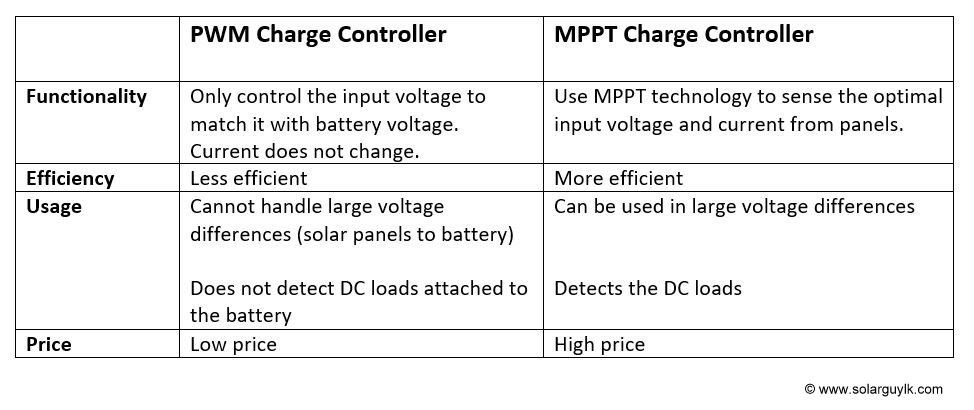

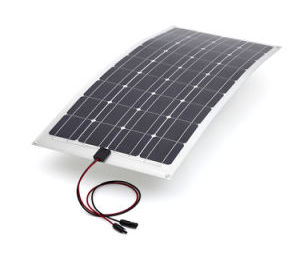
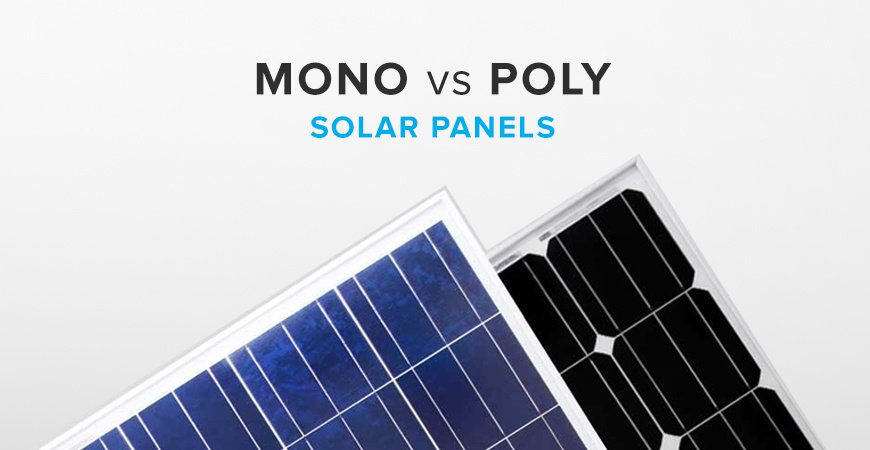
This is the right website for anyone who hopes to find out about this topic. You understand a whole lot its almost hard to argue with you (not that I really will need toÖHaHa). You definitely put a fresh spin on a subject thats been written about for years. Wonderful stuff, just great!
Thanks for your blog, nice to read. Do not stop.
Itís difficult to find educated people for this topic, however, you seem like you know what youíre talking about! Thanks